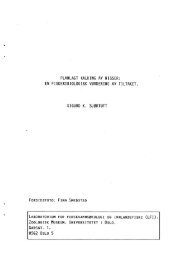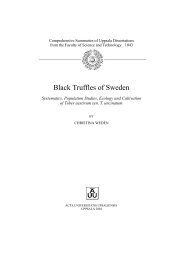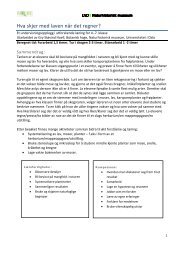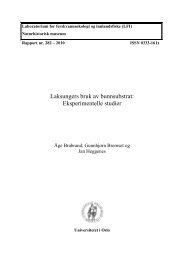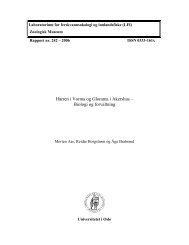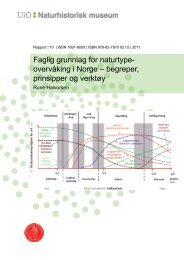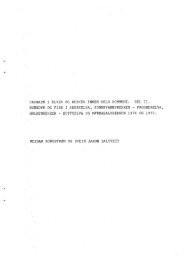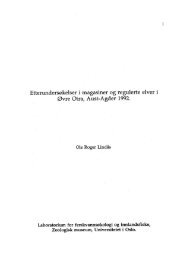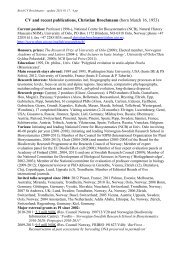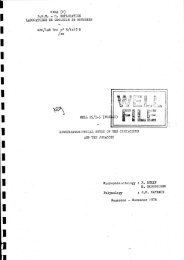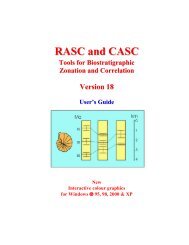Elaphomyces virgatosporus in NW Norway - the northernmost ...
Elaphomyces virgatosporus in NW Norway - the northernmost ...
Elaphomyces virgatosporus in NW Norway - the northernmost ...
Create successful ePaper yourself
Turn your PDF publications into a flip-book with our unique Google optimized e-Paper software.
Læssøe, T, Jordal, JB, Nielsen, JGB, Holtan,<br />
D, Larsen, PG, 2009. <strong>Elaphomyces</strong> <strong>virgatosporus</strong><br />
<strong>in</strong> <strong>NW</strong> <strong>Norway</strong> - <strong>the</strong> nor<strong>the</strong>rnmost<br />
records of a rare truffle. Agarica 28, 43-49.<br />
KEYWORDS<br />
Elaphomycetaceae, hypogeous fungi, Corylus,<br />
relic species<br />
NØKKELORD<br />
løpekuler, underjordiske sopper, hassel, relikt<br />
ABSTRACT<br />
The first Norwegian records of <strong>Elaphomyces</strong><br />
<strong>virgatosporus</strong> Hollós are reported from two<br />
sites <strong>in</strong> Western <strong>Norway</strong> (Møre og Romsdal<br />
County) <strong>in</strong> 2008. All material was collected<br />
underneath old Corylus avellana <strong>in</strong> ancient,<br />
previously coppiced stands <strong>in</strong> dark, light soil<br />
with sparse herbaceous ground cover. No o<strong>the</strong>r<br />
species of <strong>Elaphomyces</strong> were found <strong>in</strong> <strong>the</strong><br />
vic<strong>in</strong>ity of <strong>the</strong> collected material. Most<br />
material was located by rak<strong>in</strong>g where red deer<br />
and/or roe deer evidently had been excavat<strong>in</strong>g<br />
truffles. They were far from evenly distributed.<br />
The species so far seems to be very rare, with<br />
a strongly disjunct distribution. The nearest<br />
sites are found <strong>in</strong> Sou<strong>the</strong>rn Sweden, and <strong>the</strong><br />
ma<strong>in</strong> population <strong>in</strong> Europe seems to be located<br />
<strong>in</strong> Hungary. The distribution of <strong>Elaphomyces</strong><br />
species <strong>in</strong> <strong>Norway</strong> is poorly known, but <strong>the</strong><br />
populations of E. <strong>virgatosporus</strong> <strong>in</strong> <strong>NW</strong><br />
Thomas Læssøe et al.<br />
<strong>Elaphomyces</strong> <strong>virgatosporus</strong> <strong>in</strong> <strong>NW</strong> <strong>Norway</strong> - <strong>the</strong> nor<strong>the</strong>rnmost<br />
records of a rare truffle.<br />
Thomas Læssøe 1 , John Bjarne Jordal 2 , Jan Gert Borgergren Nielsen 1 , Dag<br />
Holtan 3 , and Perry Gunnar Larsen 4<br />
1 Department of Biology, Univ. of Copenhagen, Universitetsparken 15, DK-2100 Copenhagen<br />
Ø, Denmark, E-mails: thomasl@bio.ku.dk and ove_orm@hotmail.com<br />
2 NO-6610 Øksendal, <strong>Norway</strong>, E-mail: john.bjarne.jordal@sunndals.net<br />
3 Box 3, NO-6249 Ørskog, <strong>Norway</strong>, E-mail: samedag@adsl.no<br />
4 Reiakvam, NO-6260 Skodje, <strong>Norway</strong>, E-mail: perrygl@onl<strong>in</strong>e.no<br />
<strong>Norway</strong> may be relics from <strong>the</strong> early, warm,<br />
postglacial period (early Holocene).<br />
SAMMENDRAG<br />
De to første funnene av løpekulearten <strong>Elaphomyces</strong><br />
<strong>virgatosporus</strong> i Norge ble gjort i Møre<br />
og Romsdal (Eikesdalen i Nesset og L<strong>in</strong>ge i<br />
Norddal) i 2008. Alle funnene ble gjort under<br />
gammel hassel, i mørk, lett jord med sparsom<br />
urtevegetasjon. Ingen andre <strong>Elaphomyces</strong>-arter<br />
ble funnet i umiddelbar nærhet. Materialet ble<br />
funnet ved å søke i groper hvor hjort og/eller<br />
rådyr hadde gravd etter underjordiske sopper.<br />
E. <strong>virgatosporus</strong> er svært sjelden, med et<br />
disjunkt utbredelsemønster. De nærmeste funnstedene<br />
ligger i Sør-Sverige, mens Ungarn<br />
synes å ha de største bestandene i Europa.<br />
Utbredelsen av løpekuler i Norge er dårlig<br />
kjent, men bestandene av E. <strong>virgatosporus</strong> på<br />
Nordvestlandet kan være relikter fra den<br />
postglasiale varmetida.<br />
INTRODUCTION<br />
Species of <strong>Elaphomyces</strong> Nees: Fr., especially<br />
some common brown species, can be very<br />
dom<strong>in</strong>ant as ectomycorrhizal partners <strong>in</strong> acid<br />
woodlands (e.g. Hawker 1954, Lange 1956).<br />
In dark, mostly light and calcareous soils, a<br />
rarer, but ra<strong>the</strong>r diverse group of “black”<br />
species can be found, f ex <strong>in</strong> association with<br />
Corylus. Nitare (2000) <strong>in</strong>cluded this group <strong>in</strong><br />
AGARICA 2009 Vol. 28 43
Thomas Læssøe et al.<br />
his work on Swedish <strong>in</strong>dicator species. He<br />
regards <strong>the</strong> species as <strong>in</strong>dicators of long<br />
cont<strong>in</strong>uity, a view previously published by<br />
Kers <strong>in</strong> a series of <strong>Elaphomyces</strong> studies (Kers<br />
1978, 1979, 1980, 1983a, 1983b, 1984, 1997)<br />
and as relics. Both authors state that <strong>the</strong>re are<br />
some differences <strong>in</strong> <strong>the</strong> ecological requirements<br />
<strong>in</strong> <strong>the</strong> six <strong>in</strong>cluded species. Five of <strong>the</strong>m<br />
would appear to belong to a sou<strong>the</strong>rn <strong>the</strong>rmophilous<br />
element only to be found south of <strong>the</strong><br />
nor<strong>the</strong>rn limit of Corylus. The widespread<br />
species, E. leveillei, occurs with Betula <strong>in</strong> thick<br />
black turf without o<strong>the</strong>r accepted <strong>in</strong>dicator<br />
species, while four of <strong>the</strong> rema<strong>in</strong><strong>in</strong>g five mostly<br />
occur on soils with relatively high pH and <strong>in</strong><br />
association with a number of co-occurr<strong>in</strong>g<br />
<strong>in</strong>dicator species such as species of Cort<strong>in</strong>arius<br />
subg. Phlegmacium. Rydberg (2007a) documented<br />
that E. striatosporus occurs <strong>in</strong> soils<br />
with a pH value around 4.5. In <strong>Norway</strong> Eckblad<br />
(1962, 1971) reported seven species of <strong>Elaphomyces</strong><br />
with three belong<strong>in</strong>g to <strong>the</strong> black group.<br />
Kers (1980) redescribed one Norwegian<br />
record of E. leveillei (under Corylus, near<br />
Gaustad <strong>in</strong> Oslo) as <strong>the</strong> highly characteristic<br />
E. striatosporus, and added a key to <strong>the</strong> Nordic<br />
black species (Kers 1981). E. striatosporus<br />
was later discovered <strong>in</strong> Sweden (Kers 1984).<br />
SEARCH FOR TRUFFLES DURING THE<br />
EIKESDAL WORKSHOP 2008<br />
Dur<strong>in</strong>g <strong>the</strong> annual Eikesdal foray and workshop<br />
<strong>in</strong> Western <strong>Norway</strong>, organized by <strong>the</strong><br />
local mycological society “Risken” <strong>in</strong> late<br />
September 2008, a special focus was placed<br />
on hypogeous fungi, and at <strong>the</strong> first site,<br />
ra<strong>the</strong>r steep slopes below Rangåfjellet, many<br />
attempts were made to locate truffles under<br />
old hazels dur<strong>in</strong>g <strong>the</strong> morn<strong>in</strong>g foray. In <strong>the</strong><br />
afternoon we cont<strong>in</strong>ued fur<strong>the</strong>r up <strong>the</strong> slope<br />
and found an area, apparently with a slightly<br />
moister microclimate and many signs of red<br />
deer (and/or roe deer) hav<strong>in</strong>g dug after food<br />
<strong>in</strong> <strong>the</strong> soil next to <strong>the</strong> old hazels. Already <strong>the</strong><br />
first of <strong>the</strong>se disturbed spots yielded a handful<br />
of dark, soil encrusted <strong>Elaphomyces</strong> with a<br />
thick black peridium seen <strong>in</strong> section. About<br />
ten collections were retrieved from this ra<strong>the</strong>r<br />
small area (ca. 50 x 30 m), and back <strong>in</strong> <strong>the</strong><br />
laboratory we discovered two th<strong>in</strong>gs: all <strong>the</strong><br />
material would appear to belong to <strong>the</strong> same<br />
species and all had <strong>the</strong> most <strong>in</strong>trigu<strong>in</strong>g striped<br />
spores. This <strong>in</strong>itially led to <strong>the</strong> assumption that<br />
we were deal<strong>in</strong>g with E. striatosporus, s<strong>in</strong>ce<br />
this species is known from <strong>Norway</strong>, and was<br />
<strong>the</strong> only striped spored Nordic species <strong>in</strong> <strong>the</strong><br />
key available to us (Eckblad et al. 2000).<br />
Never<strong>the</strong>less, not least <strong>the</strong> size of <strong>the</strong> fruitbodies<br />
and <strong>the</strong> thickness of <strong>the</strong> peridia made<br />
us wonder. Later we came across a onl<strong>in</strong>e<br />
description from <strong>the</strong> Swedish red list of E.<br />
<strong>virgatosporus</strong> Hollós (Bohl<strong>in</strong> 2002/2006),<br />
and we also got hold of Johan Nitare’s<br />
“Signalarter” that immediately told us that <strong>the</strong><br />
latter name was <strong>the</strong> right one (Nitare 2000:<br />
266-267). Dur<strong>in</strong>g <strong>the</strong> follow<strong>in</strong>g days we<br />
hunted truffles on all sites. E. <strong>virgatosporus</strong><br />
was not refound dur<strong>in</strong>g <strong>the</strong> foray, but four<br />
o<strong>the</strong>r species of truffles were (E. muricatus,<br />
E. granulatus, Genea hispidula and Hydnotrya<br />
tulasnei). Follow<strong>in</strong>g this success Dag Holtan<br />
aga<strong>in</strong> found E. <strong>virgatosporus</strong> under old hazels<br />
at Sunnmøre. The material from Eikesdalen<br />
was discussed with S. Sivertsen who also<br />
attended <strong>the</strong> foray, and later some material<br />
was sent to Johan Nitare who duly confirmed<br />
<strong>the</strong> agreed determ<strong>in</strong>ation from both sites. The<br />
comb<strong>in</strong>ation of thick, dark peridia <strong>in</strong> section,<br />
striate spores and a spore size range around<br />
17-18 µm <strong>in</strong> diam. make E. <strong>virgatosporus</strong><br />
stand out from all o<strong>the</strong>r species of <strong>Elaphomyces</strong><br />
(e.g. pers. com. J. Nitare).<br />
A brief description of <strong>the</strong> collected material<br />
Ascomata irregularly globose, strongly encrusted<br />
with a thick layer of soil, about <strong>the</strong> size<br />
of a hazelnut to slightly bigger (TL-13512<br />
exsic. 11-35 mm diam) (Fig 1). Outer surface<br />
m<strong>in</strong>utely and densely warty, very dark brown;<br />
<strong>in</strong> section with a thick (up to 5 mm) black r<strong>in</strong>d<br />
44 AGARICA 2009 Vol. 28
Figure 1. <strong>Elaphomyces</strong> <strong>virgatosporus</strong> and a hazel nut at <strong>the</strong><br />
collection site <strong>in</strong> Eikesdalen. Foto: John Bjarne Jordal.<br />
and with<strong>in</strong> this a white layer. Gleba when young<br />
white and cottony, later very dark brown with<br />
a tendency to have a central, dark cavity, and<br />
f<strong>in</strong>ally fibrillose-powdery. Ascospores globose,<br />
dark brown, with an <strong>in</strong>tricate ornament of more<br />
or less parallel ridges creat<strong>in</strong>g a striped impression<br />
(Fig. 2), ca. 18-19 µm diam. For a more<br />
complete, illustrated account, see Kers (1997).<br />
Selected illustrations: Kers (1997): 26-27 (<strong>in</strong>cl.<br />
SEM of ascospores), Montecchi and Saras<strong>in</strong>i<br />
(2000): 86-87 (<strong>in</strong>cl. SEM of ascospores).<br />
Material exam<strong>in</strong>ed<br />
Locality 1, Eikesdal, <strong>Norway</strong>, Møre og<br />
Romsdal, Nesset municipality, Eikesdalen,<br />
under Rangåfjellet:<br />
(1) under old Corylus, 26.09.2008, leg. and<br />
det. T. Læssøe and J.G.B. Nielsen, TL-13512<br />
(C)<br />
Figure 2. Ascospores (DIF) from TL-13512.<br />
Thomas Læssøe et al.<br />
(2) <strong>in</strong> soil under Corylus,<br />
UTM(WGS84): MQ 5945 2610,<br />
Alt.: 132 m, 26.09.2008, leg. and<br />
det. Læssøe, Thomas; Nielsen,<br />
Jan G.B.; Nilsen, Terje Spolén;<br />
Jordal, John Bjarne; conf. Nitare,<br />
Johan (Dec. 08), F69242 (O)<br />
(3) <strong>in</strong> soil under Corylus,<br />
UTM(WGS84): MQ 5948 2609,<br />
Alt.: 130 m, 26.09.2008, leg. and<br />
det. Læssøe, Thomas; Nielsen,<br />
Jan G.B.; Nilsen, Terje Spolén;<br />
Jordal, John Bjarne, F69247 (O)<br />
(4) <strong>in</strong> soil under Corylus, down to<br />
15 cm depth, UTM(WGS84):<br />
MQ 5947 2611, Alt.: 130 m, 26.09.2008, leg.<br />
and det. Læssøe, Thomas; Nielsen, Jan G.B.;<br />
Nilsen, Terje Spolén; Jordal, John Bjarne,<br />
F69248 (O)<br />
Locality 2, L<strong>in</strong>ge<br />
<strong>Norway</strong>, Møre og Romsdal, Norddal municipality,<br />
Storfjorden: L<strong>in</strong>ge, <strong>in</strong> soil under old<br />
Corylus, UTM(WGS84): MQ 06210 07428,<br />
Alt.: 83 m, 29.09.2008, leg. Dag Holtan, det.<br />
Perry G. Larsen, conf. Johan Nitare (Jan.<br />
2009), F69584 (O).<br />
Description of <strong>the</strong> localities and specific<br />
sites.<br />
Locality 1, Eikesdal<br />
The locality is situated on <strong>the</strong> north side of<br />
Eikesdal <strong>in</strong> Nesset municipality, under <strong>the</strong><br />
steep mounta<strong>in</strong> Rangåfjellet (1500 m) at<br />
about 130 meters a.s.l. This is a deciduous<br />
forest dom<strong>in</strong>ated by Corylus avellana, with<br />
scattered Ulmus glabra, Betula verrucosa,<br />
Salix caprea, Alnus <strong>in</strong>cana and Populus<br />
tremula. All Corylus stands <strong>in</strong> <strong>the</strong> area are<br />
probably very old, with a long cont<strong>in</strong>uity.<br />
The climate is warm <strong>in</strong> summer. The soil is<br />
rich <strong>in</strong> humus and also sand and small stones<br />
orig<strong>in</strong>at<strong>in</strong>g ma<strong>in</strong>ly from scree material. The<br />
AGARICA 2009 Vol. 28 45
Thomas Læssøe et al.<br />
rock consists ma<strong>in</strong>ly of gneisses, but <strong>the</strong>re are<br />
scattered places where base rich ground water<br />
appears. The site of <strong>Elaphomyces</strong> <strong>virgatosporus</strong><br />
has a slope of about 10-25 degrees<br />
towards <strong>the</strong> south-southwest. The vegetation is<br />
partly scarce, but vascular plants like Galium<br />
odoratum, Viola riv<strong>in</strong>iana and Rubus saxatilis<br />
are common (see photo). In <strong>the</strong> vic<strong>in</strong>ity many<br />
rare fungi like Cantharellus amethysteus,<br />
Cort<strong>in</strong>arius olearioides, Lycoperdon ech<strong>in</strong>atum,<br />
Peziza saniosa, Porphyrellus porphyrosporus<br />
and Russula aurea have been found, and <strong>in</strong><br />
addition a lot of rare wood-<strong>in</strong>habit<strong>in</strong>g fungi.<br />
A lot of specimens of E. <strong>virgatosporus</strong> were<br />
found by digg<strong>in</strong>g at places where red deer or<br />
roe deer had dug before us. Several o<strong>the</strong>r<br />
species with a disjunct, relictual distribution<br />
pattern are known from Eikesdalen, like Lycoperdon<br />
ech<strong>in</strong>atum and Amaurodon viridis.<br />
For a general description of Eikesdal, fur<strong>the</strong>r<br />
details about <strong>the</strong> deciduous forests and <strong>the</strong>ir<br />
diversity see Jordal (2005), Gaarder et al. (2005)<br />
and <strong>the</strong> Norwegian Mycological Database.<br />
Locality 2, L<strong>in</strong>ge<br />
The locality is situated west of L<strong>in</strong>ge <strong>in</strong><br />
Norddal municipality, just above <strong>the</strong> place<br />
where <strong>the</strong> ferry leaves across <strong>the</strong> Storfjord<br />
from L<strong>in</strong>ge to Eidsdal, at 83 meters a.s.l.<br />
This is an old deciduous forest dom<strong>in</strong>ated by<br />
Figure 3. Habitat of <strong>Elaphomyces</strong> <strong>virgatosporus</strong> <strong>in</strong> Eikesdalen.<br />
Foto: John Bjarne Jordal.<br />
Figure 4. Distribution of <strong>Elaphomyces</strong> <strong>virgatosporus</strong><br />
<strong>in</strong> <strong>Norway</strong>. The county of Møre og<br />
Romsdal is marked by green colour.<br />
Corylus, with scattered Betula verrucosa and<br />
Salix caprea. The vegetation is here also partly<br />
scarce, but vascular plants like Brachypodium<br />
sylvaticum, Sanicula europaea, Galium<br />
odoratum, Melica nutans, Viola riv<strong>in</strong>iana<br />
and Fragaria vesca are common. The forest<br />
is probably among <strong>the</strong> oldest Corylus stands<br />
<strong>in</strong> <strong>the</strong> Storfjorden area. The climate is warm<br />
<strong>in</strong> summer. The soil is rich <strong>in</strong> humus and also<br />
sand and small stones orig<strong>in</strong>at<strong>in</strong>g ma<strong>in</strong>ly from<br />
scree material. The rock consists ma<strong>in</strong>ly of<br />
gneisses, but <strong>the</strong>re are scattered places where<br />
base rich ground water appears, orig<strong>in</strong>at<strong>in</strong>g<br />
from calcareous rocks <strong>in</strong> <strong>the</strong> mounta<strong>in</strong><br />
massif. The site of <strong>Elaphomyces</strong><br />
<strong>virgatosporus</strong> had a slope of<br />
about 10-15 degrees towards <strong>the</strong><br />
south-southwest. In <strong>the</strong> vic<strong>in</strong>ity<br />
fungi like Cantharellus amethysteus,<br />
Russula aurea, Cort<strong>in</strong>arius<br />
praestans, C. olearioides<br />
and Lycoperdon ech<strong>in</strong>atum have<br />
been found. Only two fruitbodies<br />
of E. <strong>virgatosporus</strong> were found<br />
ly<strong>in</strong>g on <strong>the</strong> ground, dug up by<br />
red deer or roe deer. Fur<strong>the</strong>r<br />
digg<strong>in</strong>g gave no result.<br />
46 AGARICA 2009 Vol. 28
Figure 5. World distribution of <strong>Elaphomyces</strong><br />
<strong>virgatosporus</strong>. A r<strong>in</strong>g marked with an arrow<br />
shows <strong>the</strong> new area for this species <strong>in</strong> <strong>Norway</strong>.<br />
Redrawn after Kers (1997).<br />
DISTRIBUTION AND ECOLOGY<br />
Fig. 5<br />
Siller et al. (2005) reported <strong>the</strong> species from<br />
at least seven sites <strong>in</strong> Hungary, mostly Fagus<br />
sylvatica dom<strong>in</strong>ated forests but also <strong>in</strong> Quercus-<br />
Carp<strong>in</strong>us forests, and often toge<strong>the</strong>r with<br />
Tuber spp. They do not give any detailed soil<br />
descriptions. One of <strong>the</strong> sites is def<strong>in</strong>ed as<br />
“Melittio-Fagetum” which would <strong>in</strong>dicate a<br />
<strong>the</strong>rmophilous, calcareous vegetation type with<br />
Melittis and Fagus sylvatica (Chlebicki pers.<br />
com.). They cite Trappe for a pers. com. where<br />
he considers E. <strong>virgatosporus</strong> to represent an<br />
ancient relic species that orig<strong>in</strong>ated before <strong>the</strong><br />
cont<strong>in</strong>ents drifted apart. The only American<br />
collection (see Kers 1997) was found <strong>in</strong><br />
Mississippi with Quercus virg<strong>in</strong>iana.<br />
Kers (1997), fur<strong>the</strong>rmore, reported on<br />
a Swiss collection from Kanton Baselland but<br />
without ecological details. In <strong>the</strong> nor<strong>the</strong>rn<br />
distribution area (Gotland, Öland, Eikesdal<br />
and L<strong>in</strong>ge) all records are so far with Corylus<br />
as <strong>the</strong> apparent mycorrhizal partner. Common<br />
vascular plants at <strong>the</strong> Gotland site were Hepatica<br />
nobilis, Sanicula europaea, Rubus saxatilis,<br />
Carex sylvatica and Epipactis hellebor<strong>in</strong>e.<br />
At <strong>the</strong> Öland site, Hepatica nobilis,<br />
Brachypodium sylvaticum and <strong>the</strong> moss<br />
Thomas Læssøe et al.<br />
Rhytidiadelphus triquetrus were mentioned.<br />
Kers also reported pH=5,49 and 6,10<br />
respectively for <strong>the</strong> Sweedish sites.<br />
The strongly disjunct distribution would<br />
appear to be highly suspect, also when consider<strong>in</strong>g<br />
that so many recent genetic studies have<br />
shown that American populations identified<br />
under European names often can be viewed<br />
as phylogenetically <strong>in</strong>dependent species (e.g.<br />
<strong>in</strong> Xerocomus, Taylor and Eberhardt pers.<br />
com). On <strong>the</strong> o<strong>the</strong>r hand Kovács et al. (2008)<br />
have <strong>in</strong> a recent paper advocated for accept<strong>in</strong>g<br />
ano<strong>the</strong>r truffle (Imaia gigantea) as one entity,<br />
despite its extreme disjunct distribution, and<br />
presumed very long genetic isolation of <strong>the</strong><br />
<strong>in</strong>dividual populations.<br />
CONSERVATION<br />
Siller et al. (2005) argued for a high protection<br />
status for E. <strong>virgatosporus</strong> <strong>in</strong> Hungary based on<br />
occurrence <strong>in</strong> few sites and <strong>the</strong>se sites be<strong>in</strong>g<br />
threatened by high game populations and also<br />
by semi-commercial truffle pick<strong>in</strong>g. Bohl<strong>in</strong><br />
(2002) recommended <strong>the</strong> species to be given<br />
legal protection <strong>in</strong> Sweden, and <strong>the</strong> Swedish<br />
red list (Gärdenfors 2005) lists <strong>the</strong> species as<br />
endangered (EN) based on criterion D (very<br />
small or restricted population) from <strong>the</strong> nature<br />
types “agricultural landscapes” and “forest”<br />
with records from Gotland and Öland (formerly<br />
mown or grazed forests). Although much<br />
<strong>in</strong>ventory<strong>in</strong>g rema<strong>in</strong>s to be done, we would<br />
recommend a similar list<strong>in</strong>g <strong>in</strong> <strong>Norway</strong>. In<br />
Sweden, E. striatosporus and E. aculeatus<br />
recently have got dedicated action plans<br />
(Rydberg 2007a, 2007b). The same would be<br />
appropriate for all sites of E. <strong>virgatosporus</strong>.<br />
It is unclear whe<strong>the</strong>r <strong>the</strong> size of deer<br />
populations, or o<strong>the</strong>r mammalian truffle<br />
hunters, can affect <strong>the</strong> conservation status of<br />
truffles. Trappe and Mazer (1977) reported<br />
on deer forag<strong>in</strong>g for truffles.<br />
AGARICA 2009 Vol. 28 47
Thomas Læssøe et al.<br />
ACKNOWLEDGEMENTS<br />
We wish to thank Johan Nitare for advice<br />
and confirmation of <strong>the</strong> determ<strong>in</strong>ations, and<br />
Wenche Eli Johansen/Risken for organiz<strong>in</strong>g<br />
<strong>the</strong> meet<strong>in</strong>g at Eikesdalen.<br />
REFERENCES<br />
Bohl<strong>in</strong> K, 2002/2006. Faktablad:<br />
<strong>Elaphomyces</strong> <strong>virgatosporus</strong> – ungersk<br />
hjorttryffel. ArtDatabanken, Sverige,<br />
http://www.artdata.slu.se/rodlista/Faktabl<br />
ad/ela_virg.PDF.<br />
Eckblad F-E, 1962. Studies <strong>in</strong> <strong>the</strong> hypogean<br />
fungi of <strong>Norway</strong>. II. Revision of <strong>the</strong> genus<br />
<strong>Elaphomyces</strong>. Nytt Mag Bot 9, 199-210.<br />
Eckblad F-E, 1971. Tillegg til Norges<br />
<strong>Elaphomyces</strong>-flora (Additions to <strong>the</strong><br />
<strong>Elaphomyces</strong> flora of <strong>Norway</strong>). Blyttia<br />
29, 13-17.<br />
Eckblad F-E, Lange M, Kers LE, 2000.<br />
<strong>Elaphomyces</strong>. In: Hansen L, Knudsen H,<br />
Nordic macromycetes 1. Nordsvamp,<br />
Copenhagen, pp. 128-130.<br />
Gaarder G, Holtan D, Jordal JB, Larsen P,<br />
Oldervik FG, 2005. Marklevende sopper i<br />
hasselrike skoger og m<strong>in</strong>eralrike furuskoger<br />
i Møre og Romsdal (Ground dwell<strong>in</strong>g<br />
fungi <strong>in</strong> Corylus dom<strong>in</strong>ated forests and<br />
m<strong>in</strong>eral rich p<strong>in</strong>e forests of Møre og<br />
Romsdal county). Møre og Romsdal fylke,<br />
Areal- og miljøvernadel<strong>in</strong>ga, rapport 3-<br />
2005, 1-101.<br />
Gärdenfors U (Ed.), 2005. Rödlistade arter i<br />
Sverige 2005 [The 2005 red list of Swedish<br />
species]. ArtDatabanken, Uppsala, 496 pp.<br />
Hawker LE, 1954. British hypogeous fungi.<br />
Philosophical Transactions of <strong>the</strong> Royal<br />
Society of London, ser. B Biological<br />
sciences 237(650), 429-546.<br />
Jordal JB, 2005. Kartlegg<strong>in</strong>g av naturtypar i<br />
Nesset kommune (Mapp<strong>in</strong>g of biologically<br />
important areas <strong>in</strong> Nesset municipality).<br />
Rapport J. B. Jordal nr. 6-2005. 162 pp.<br />
Kers L-E, 1978. <strong>Elaphomyces</strong> maculatus<br />
found <strong>in</strong> Sweden. Bot. Notiser 131, 419-<br />
422.<br />
Kers L-E, 1979. <strong>Elaphomyces</strong> aculeatus<br />
funnen i Sverige. Svensk Bot. Tidskr. 73,<br />
123-126.<br />
Kers L-E, 1980. A new species of <strong>Elaphomyces</strong><br />
Nees ex Fr. Subgen. Malacoderma Vitt.<br />
Bot. Notiser 133, 149-153.<br />
Kers L-E, 1981. On <strong>the</strong> identity of<br />
<strong>Elaphomyces</strong> ulig<strong>in</strong>osus Hesse<br />
(Ascomycetes.) Nord. J. Bot. 1, 795-800.<br />
Kers L-E, 1983a. <strong>Elaphomyces</strong> anthrac<strong>in</strong>us<br />
och E. leveillei i Norden. Svensk Bot.<br />
Tidskr. 77, 43-56.<br />
Kers L-E, 1983b. Några svenska fynd af<br />
hypogeiska svampar (Some Swedish<br />
records of hypogeic fungi). Svensk Bot.<br />
Tidskr.77, 259-268.<br />
Kers L-E, 1984. <strong>Elaphomyces</strong> striatosporus<br />
found <strong>in</strong> Sweden. Nord. J. Bot. 4, 71-73.<br />
Kers L-E, 1997. <strong>Elaphomyces</strong> <strong>virgatosporus</strong><br />
funnen i Sverige. Svensk Bot. Tidskr. 91,<br />
25-36.<br />
Kovács GM, Trappe JM, Alsheikh AM, Bóka<br />
K, Elliott TF, 2008. Imaia, a new truffle<br />
genus to accomodate Terfezia gigantea.<br />
Mycologia 100, 930-939.<br />
Lange M, 1956. Danish hypogeous macromycetes.<br />
Dansk Bot. Ark. 16(1), 1-84.<br />
Nitare J, 2000. Signalarter. Indikatorer på<br />
skyddsvärd skog. Flora över kryptogamer<br />
(Indicators for valuable forest areas. A<br />
cryptogam flora). Skogsstyrelsens Förlag,<br />
Jönköp<strong>in</strong>g, 384 pp.<br />
Norwegian Mycological Database, 2009.<br />
http://www.nhm.uio.no/botanisk/nxd/sop<br />
p/nsd_b.htm<br />
Montecchi A, Saras<strong>in</strong>i M, 2000. Funghi<br />
ipogei d’Europa. A.M.B., Fondazione<br />
Centro Studi Micologici, 714 pp.<br />
48 AGARICA 2009 Vol. 28
Rydberg H, 2007a. Åtgärdsprogram för<br />
strimsporig hjorttryffel 2007-2010<br />
(<strong>Elaphomyces</strong> striatosporus) (Action plan<br />
for <strong>Elaphomyces</strong> striatosporus <strong>in</strong><br />
Sweden). Naturvårdsverket rapport 5720,<br />
37 pp. Available from:<br />
http://www.naturvardsverket.se/Documen<br />
ts/publikationer/620-5720-0.pdf<br />
Rydberg H, 2007b. Åtgärdsprogram för<br />
taggig hjorttryffel 2007-2010 (<strong>Elaphomyces</strong><br />
aculeatus) (Action plan for<br />
<strong>Elaphomyces</strong> aculeatus <strong>in</strong> Sweden).<br />
Naturvårdsverket rapport 5721, 48 pp.<br />
Available from:<br />
http://www.naturvardsverket.se/Documen<br />
ts/publikationer/620-5721-9.pdf<br />
Siller I, Vasas G, Pál-Fám F, Bratek Z,<br />
Zagyva I, Fodor L, 2005. Hungarian<br />
distribution of <strong>the</strong> legally protected<br />
macrofungi species. Studia bot. hung. 36,<br />
131-163.<br />
Trappe JM, Mazer C, 1977. Ectomycorrhizal<br />
fungi: <strong>in</strong>teractions of mushrooms and<br />
truffles with beasts and trees. In Wal<strong>the</strong>rs<br />
T (ed). Mushrooms and man, an<br />
<strong>in</strong>terdiscipl<strong>in</strong>ary approach to mycology,<br />
pp 165-179.<br />
Thomas Læssøe et al.<br />
AGARICA 2009 Vol. 28 49



